
John Reynolds is widely considered to be one of finest artists in New Zealand, with work held in all of this country’s major private and public collections.


John Reynolds is widely considered to be one of finest artists in New Zealand, with work held in all of this country’s major private and public collections.
In cartoons and graphic novels, words in speech or thought bubbles hang above the character’s head like a cloud. This artwork is one great big cloud of thousands of words.
The work by artist John Reynolds is called Cloud . It’s made of 7081 individual canvas panels, each of them painted with a word or phrase that comes from the Oxford Dictionary of New Zealand English – for example, tin-arse, tough bickies, waka, pumice


soil, corner dairy, puku, no-hoper. They’re all part of the English that people in New Zealand speak.
‘John Reynolds has always worked with language in his art,’ says curator Charlotte Huddleston. ‘He likes to play with words and he’s had a


long fascination with the Dictionary of New Zealand English .’
Reynolds created the work to reflect Aotearoa’s connection to the community of English-speaking nations. At the same time he wanted to highlight what is local and regional about the English that people in this country speak.
He arranged the words to create the feeling of a billowing, condensing
‘It took a team of five or six people six days altogether to install Cloud at Te Papa,’ says Charlotte. ‘John was here, of course, leading the charge. We designed a special storage system for it as well, with twelve canvases in a tray, five trays in a box and a total of 125 boxes in a crate. All the parts are numbered and catalogued so we know where every single word or phrase is.’
It’s made of 7081 individual canvas panels, each of them painted with a word or phrase.
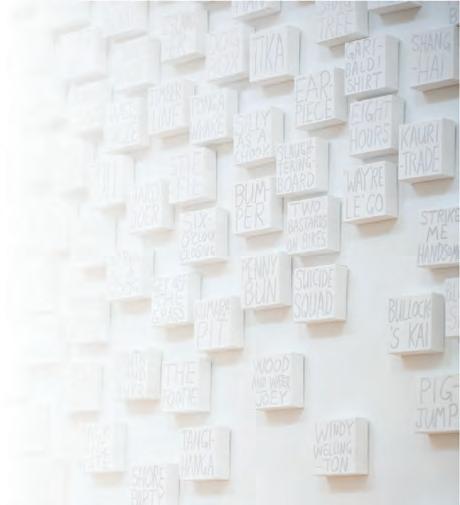
cloud of language – an impression of what constantly surrounds people at home, in the street or the classroom or workplace.
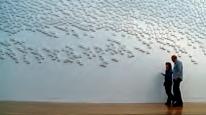
‘You can let your eyes roam around and read,’ says Charlotte, ‘and you can make up little poems or absurd sentences.’
A large and complex artwork like this needs a lot of care to put on display – and to store.
And that’s important because Cloud is unique every time it’s displayed. Just like a cloud that changes shape depending on the weather, this artwork changes shape depending on the space you see it in.
A work table for the installation of Cloud. The work’s title refers to language being like a cloud and to Aotearoa, the land of the long white cloud, home to New Zealand’s form of English.
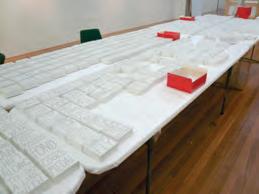

Gottfried Lindauer’s portrait of the renowned ‘Guide Sophia’, 1896. Te Paea Hinerangi was fluent in both Màori and English, a huge advantage in dealing with English- speaking tourists.
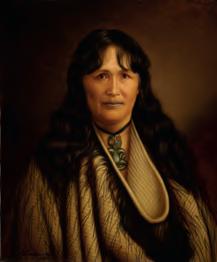
Hinerangi’s hei tiki, made of pounamu from Westland. Both its suspension holes have broken, so it was muchobviously worn over a long time.
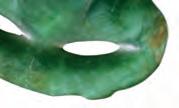
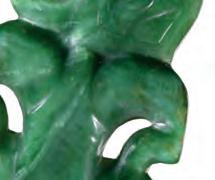
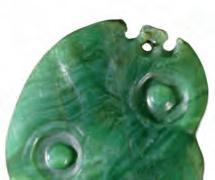





Hinerangi’s house at Te Wairoa in June 1886, half buried but still standing amid the debris of the eruption.

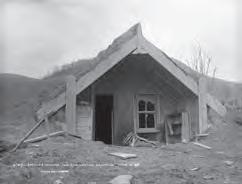


Hei tiki may look small, but they are powerful treasures. They are passed down in families from one generation to another, gathering strength and stories from the people who wear them.
Hei tiki are worn around the neck – ‘hei’ means to suspend, ‘tiki’ has various meanings to do with ancestors. The design has been popular for hundreds of years. Many hei tiki are carved from pounamu, like this one, though you’ll also see them made of whalebone and wood. Carvers these days also use materials like acrylic.

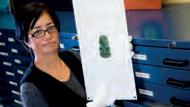
to see the renowned Pink and White Terraces. They were on the shores of Lake Rotomahana, at the foot of Mount Tarawera.

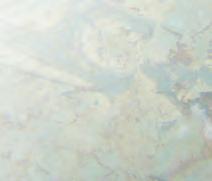
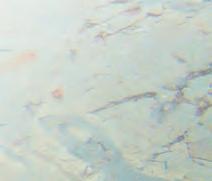

Late in May 1886 she told of a disturbing experience in which she saw the lake’s water level suddenly fall and rise again. Then a canoe appeared in the distance. At first there was one person in it, but as it came
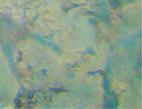



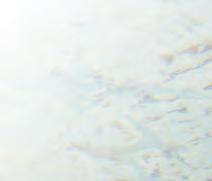
mud and rocks began raining down, burying the landscape for miles around. Sophia managed to shelter sixty-two people from her village, Te Wairoa, inside her house. The house was strongly constructed and its steeply pitched roof stood up to the weight of the falling debris. But some 150 people living in the area died.
After this, Sophia went to live in Whakarewarewa in Rotorua and became equally famous guiding visitors to the thermal area there. She encouraged many other local women to earn a living from guiding.
This hei tiki belonged to Te Paea (Sophia) Hinerangi, who lived in the Rotorua area from the 1870s to the early 1900s. She was known to thousands of tourists as Guide Sophia. For sixteen years, she ran a highly successful business taking visitors
closer there were thirteen, all with dogs’ heads. The phantom canoe then disappeared. Sophia saw this as an omen that her days of guiding on the lake were coming to an end.
A few days later, on 10 June 1886, Mount Tarawera erupted. Ash,
Although Sophia’s hei tiki may never be worn again, its stories will continue to be shared, like those of many other hei tiki worn today. Ask someone who’s wearing one!
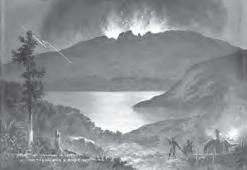
An artist’s impression of Mount Tarawera erupting, 1886. People in Auckland heard the explosion and thought it was distant gunfire.
Curator Awhina Tamarapa with Te Paea Hinerangi’s hei tiki. The priceless taonga is now in Te Papa for safe keeping, but its stories continue to be told.
Then a canoe appeared in the distance. At first there was one person in it, but as it came closer there were thirteen, all with dogs’ heads.
New Zealand’s and South Africa’s rugby relationship has had some tumultuous moments – both glorious and notorious, depending on your point of view. A ball and a scooter helmet tell of events that have reverberated off the pitch for decades.
Halt All Racist Tours organiser John Minto’s scooter helmet, bought by his girlfriend for head protection during protests against the 1981 Springbok tour of New Zealand.

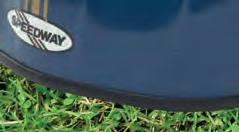
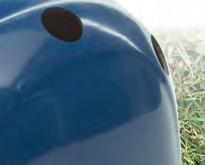
The ball was used in the fourth test of the 1956 series between the Springboks and the All Blacks. The game took place at Eden Park in Auckland. It brought rugby-mad New Zealand to a standstill.


‘The All Blacks had won two tests,’ explains curator Kirstie Ross. ‘The Springboks had won one. This was the decider – for a series draw, or a win – and the All Blacks won 11–5. They’d never cracked the ’Boks in a series before. The crowd went mad, the country went mad – it was a moment of glory for a nation united by rugby.’
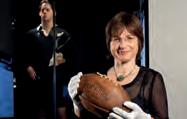
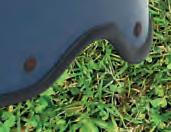
But South Africa’s apartheid laws meant that no black African could play for the Springboks until 1992. No Māori could play for the All Blacks touring in South Africa until 1970, and then only as an ‘honorary white’.
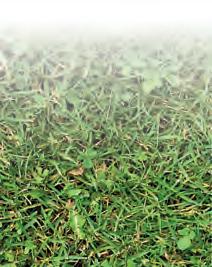
New Zealand. M āor i touri n th en o O w ith a
Opposition to playing sport with apartheid-era South Africa
Minto wearing his trademark helmet during the 1981 Springbok tour.gathered strength over the years. Organisations like Halt All Racist Tours (HART) campaigned vigorously to stop the planned 1981 Springbok tour
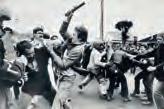
of New Zealand. When the tour went ahead, protest spilled on to the streets and the country divided along proand anti-tour lines.

‘One of the most famous protests took place at the test match in Hamilton on 25 July,’ says Kirstie. ‘The country came to a standstill again –but for a very different reason.’
Just before kick-off, 350 protesters invaded the pitch. The police tried to clear the field, but the game ended up being cancelled. Outside the grounds, all hell broke loose when rugby fans vented their frustration on the protesters.
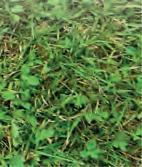
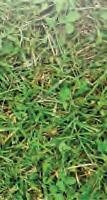

‘John Minto, a HART protest leader, was chased by angry fans into a house and attacked,’ says Kirstie. ‘So his girlfriend, fearing for his safety, went out and purchased this scooter helmet for him. And apparently it was very effective. It got a few whacks, but it kept his head protected.’
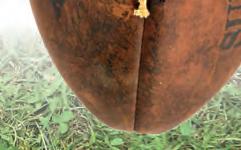
Today’s All Black–Springbok encounters are strictly sporting affairs. But these two treasures keep alive highlights – in celebrations and conflicts –of a great rugby rivalry.
t
The b all used in the seriesdeciding fourth test match of the Springboks’ 1956 tour g of New Zealand. N ew Z ea a pg


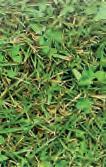
Overview of the capacity-crowd fourth test match of the Springboks’ 1956 tour, at Eden Park, Auckland.
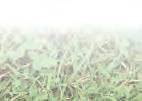
Springbok tour supporters clash with protesters, Sandringham Road, Auckland, September 1981.
s
Just before kick-off, 350 protesters invaded the pitch ... all hell broke loose when rugby fans vented their frustration on the protesters.
There’s an old tale among sailors that it’s disastrous to harm an albatross, the world’s largest and most spectacular seabird. ‘With my cross-bow / I shot the Albatross’, confesses the sailor in ST Coleridge’s The Rime of the Ancient Mariner, a famous poem about the troubles that ensue.
These days, albatrosses still die as a result of encounters with people at sea, mostly because of fishing. Their bodies are often sent to Te Papa. But many others are brought in by people who have found them dead on shore.
‘A lot of information about the bird is encrypted in its feathers,’ says Sandy. ‘There’s genetic information, but we can find out about nutrition as well. There are albatrosses here that died in the 1880s. We can tell from their feathers what those birds were eating then.’

Some of the birds come from times of terrible weather, which can have a disastrous effect even on large, strong fliers like albatrosses. The storm that wrecked the Wahine in 1968 is one example.
‘The 200-kilometre-per-hour winds blew the albatrosses against the cliffs,’ Sandy says. ‘Ninety-six of them ended up at the museum, some of them still alive. I was working in the museum as a student then and I brought two live ones in myself.’
‘We’ve got two thousand albatrosses here at Te Papa,’ says curator Sandy Bartle. ‘It’s the biggest collection of albatrosses in the world.’
The museum scientists do their best to make sure these birds did not die in vain. First they find out the cause of the bird’s death. Then they preserve the feathers and skin for research.
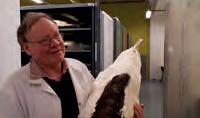
Some of those live birds were able to be released again. And for the birds that join the collection, a valuable life in research begins. But how do the scientists make the specimens last?
‘Some are preserved as skins. They get turned inside out, all the meat and bones are removed and they’re dried. Insects pose the greatest danger to them then.’
And that’s the reason a pungent smell comes from the collection’s
‘We’ve got two thousand albatrosses here at Te Papa, it’s the biggest collection in the world.’

cupboards. It’s a natural compound called camphor and it works like an insect repellent. The collection has been bug-free since 1930 because of it. No further harm will come to these albatrosses!
A albatrosswandering taxidermied with its wings at full stretch. The bird was caughtaccidentally on a fishing longlineboat’s in 1993.
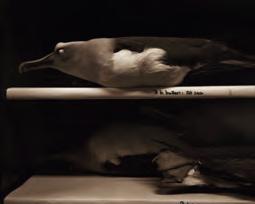
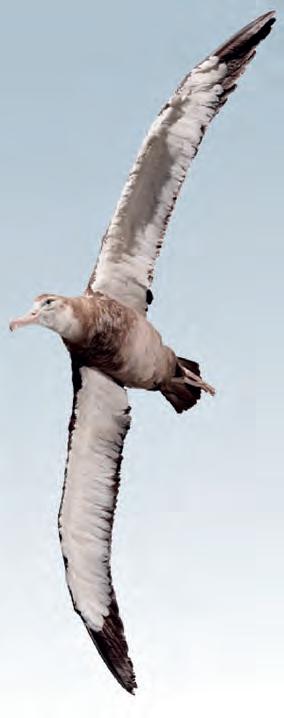 This photograph by Laurence Aberhart shows albatross specimens that Te Papa holds in storage, as part of its birds collection. The image is also in the museum — in its photography collection.
This photograph by Laurence Aberhart shows albatross specimens that Te Papa holds in storage, as part of its birds collection. The image is also in the museum — in its photography collection.
The interisland ferry Wahine listing heavily during the storm of 10 April 1968. The storm was a disastrous event for all kinds of birds, even strongfliers like albatrosses.
X-ray images showed there was a body yg inside the mummy’s y wrappings. Studies y of the confippgimages rmed Mehit’s g gender and shed light on her age. g
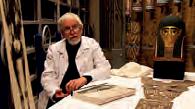

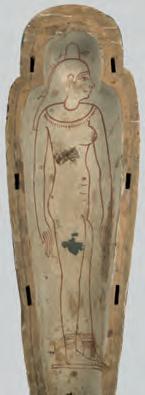

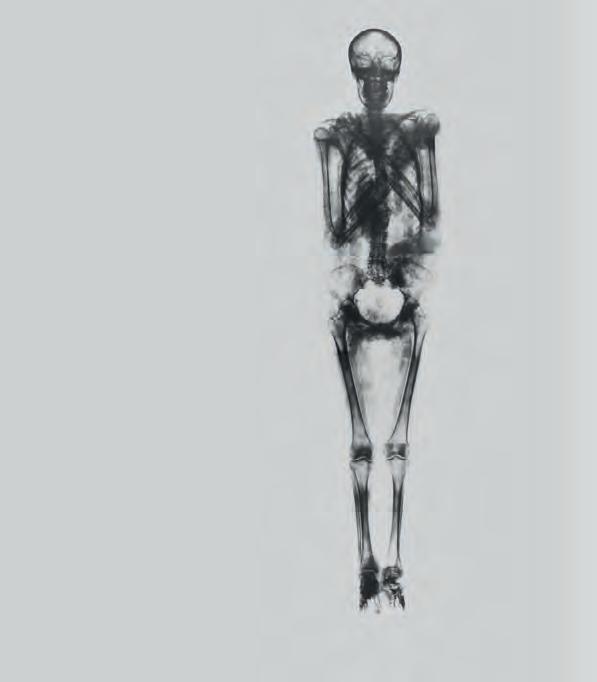
A CAT scan of Mehit’s mummy.

Mehit-em-Wesekht’s coffin. The mummy and coffin were bought from the Egyptian government, then donated to the museum. y g This was a time when many mummies were being found. gypg
Collection manager Ross O’Rourke. He has cared for and researched Mehitem-Wesekht for over half a century.
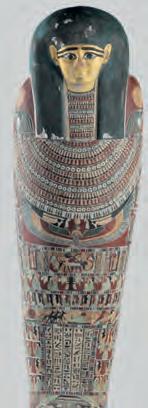
The mummy and coffin of Mehit-em-Wesekht were given to Te Papa’s predecessor, the Colonial Museum, in 1885. This was at the height of a craze for artefacts dug up from sites of ancient cultures.
Victorian people were especially intrigued by the discovery of ancient Egyptian treasures. Any self-respecting museum at that time would jump at the chance of having something like a mummy to exhibit.
Mehit was on display at the museum for close to a century. But for a while people there didn’t know much about her.
‘Until the 1950s, everybody thought this was the mummy of a man, a priest,’ says collection manager Ross O’Rourke. ‘It should have been obvious that she was a woman because males normally have a false
beard on their images. But then an Egyptologist from England came here. She read the hieroglyphics on the coffin and it became clear this was a female mummy.’
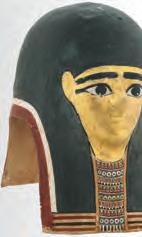
Ross and Mehit go back to 1960, when Ross started working at the museum.
‘My goal was to find out whether there was a person inside the wrappings,’ says Ross. ‘So I got the


She was the daughter of a temple priest and priestess in a town called Akhmim, and had lived about 2300 years ago.
‘Obviously she was given this sort of burial because of her parents’ status,’ says Ross. ‘But the family was probably not very rich. For example, they couldn’t afford to have her death mask made from a mould of Mehit’s face. They would have bought a pre-
mummy X-rayed – and showed that this was the real deal.’
He also found out that this was a young person, probably about eighteen years old, as her wisdom teeth had not yet come through.
Only the richest people could afford solid gold masks. The nose of Mehit’s mask has been knocked off — possibly by a tomb robber checking whether it was gold or just gilt.
made one. And they could only afford a mask painted with gilt, not one of solid gold.’
Today, Mehit is at rest in airconditioned storage at Te Papa. Her mummy and coffin are both very fragile, and attitudes have changed.
Māori in particular regard human remains as tapu, not for display, and New Zealand museums have come to respect that. At a recent exhibition, Mehit’s coffin was shown, but her mummy remained in storage.
She was the daughter of a temple priest and priestess in a town called Akhmim, and had lived about 2300 years ago.
1994.
beast
of corned beef tins
But with Pisupo Lua Afe (Corned Beef 2000) artist Michel Tuffery is also telling several stories about life in the Pacific.
‘The sculpture presents a nonPolynesian animal with tins of a commercial product that Polynesians instantly recognise,’ says curator Sean Mallon.
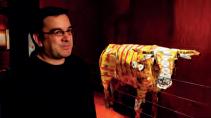
In some Pacific cultures, a favourite gift on special occasions like weddings, funerals or feasts is also a popular food: beef. But not usually the fresh sort. Though there are plenty of cattle farmed in the Pacific, the most prestigious form of their meat is the kind that comes in a tin: corned beef. In Samoa, it’s known as ‘pisupo’.
 Curator Sean Mallon with Pisupo Lua Afe (Corned Beef 2000) on display at Te Papa. This was the first of a series of corned beef tin sculptures made by Michel Tuffery in the 1990s.
Pisupo Lua Afe (Corned Beef 2000), made by Tuffery in
The brand of corned beef was a product made by a New Zealand meat company and sold in Fiji.
Curator Sean Mallon with Pisupo Lua Afe (Corned Beef 2000) on display at Te Papa. This was the first of a series of corned beef tin sculptures made by Michel Tuffery in the 1990s.
Pisupo Lua Afe (Corned Beef 2000), made by Tuffery in
The brand of corned beef was a product made by a New Zealand meat company and sold in Fiji.
A cattle
made out
... it’s a striking idea for a sculpture. And an impressive and very skilful piece of work to look at.
Pisupo is a name given to all tinned foods, from back in the colonial period. The first tinned food Samoans experienced was pea soup. Add an ‘o’ to that – because Samoan words never end in consonants – and you get ‘pisupo’. Soon that’s what all tinned food got called.
The sculpture is one of the most popular artworks on display at Te Papa.
‘Some people are offended by it. They see it as an irreverent treatment of something prestigious,’ says Sean. ‘However, Michel’s looking beyond prestige. Corned beef is high in salt and fat – just the kind of food that causes health and obesity problems
among Pacific people. So this sculpture is a comment on that.’
Tuffery also puts the spotlight on how an import like tinned food
Tuffery is a Polynesian artist born in Wellington to a Samoan mother and a Rarotongan and Tahitian father.
has come to play such a big part in customs of feasting and gift-giving.
‘He’s drawing attention to how global trade and colonial economies have affected Pacific island cultures,’ says Sean.
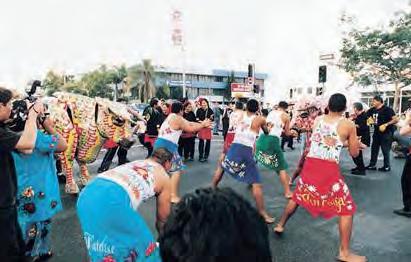
In 1999 Tuffery developed his corned beef ideas further in a multimedia piece Povi Tau Vaga (The Challenge), featuring two motorised steers in combat and over eighty performers.
‘He’s one of the most prolific Pacific island artists in New Zealand,’ says Sean. ‘He’s worked really hard over the years to express his interests in history and the environment and culture through his art. He’s one of those people who’s multicultural in both his background and his approach to his work.’
With Pisupo Lua Afe , Michel Tuffery has created a unique expression of the art of gifts – and of recycled tins.
The sculpture is one of the most popular artworks on display at Te Papa.
Over 100,000 men went overseas during World War II, to serve in New Zealand’s armed forces. Someone had to do the jobs they left behind. Down on the farm, the Land Girls often stood in for the men, including doing the hardest physical work.
At the time, this was quite a change. Usually only men had those kinds of jobs. Officially, 2711 young women were signed up as Land Girls in the government’s Women’s Land Service. Hundreds more worked on their family farms, but without formal recognition.
‘Land Girls had to do everything a farmer would do,’ says curator Stephanie Gibson: ‘fencing, milking, crutching, slaughtering, going everywhere on horses.’
a southern Wairarapa farm. They were totally inexperienced.
One day the farmer asked the girls to slaughter an old ram in the woolshed. It was about to be dog tucker, literally! Doris sat on the ram and held it down while Madge tried to cut its throat. She didn’t do the job properly, and the ram ran around spraying blood everywhere. They had to get the farmer to come and finish the job.
Doris Whiting’s killing knife, which she bought at a local farm supplies store in preparation for her job as a Land Girl.
Elizabeth Williams’s Land Girl overalls. Recruits received three sets as part of their uniform.
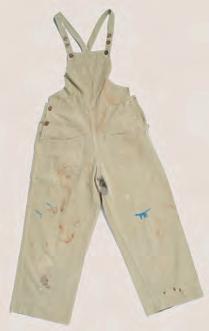
Each Land Girl was issued with three sets of overalls as part of their working uniform.
‘Elizabeth Williams worked on her father’s property in Poverty Bay and also a neighbour’s property,’ says Stephanie. ‘But she became an official Land Girl and got the overalls shown here. She carried on using them for the rest of her life – for farming, for painting, any sort of messy work.’

The killing knife shown here belonged to Doris Whiting. She was a twenty-two-year-old dressmaker from Pahiatua who signed up with her friend Madge Richardson to work on

But Doris and Madge became experts even at slaughtering, and Doris’s killing knife became a stand-by in her kitchen for over fifty years.
‘That knife in a drawer wouldn’t mean much to anybody else,’ says Stephanie. ‘But to Doris it recalled one of the happiest times in her life – when she did something meaningful for her country.’
y e en r , g
The knife and the overalls represent the stories of these women, but also of many others whose contribution to the home front during the war has never been properly recognised.
One day the farmer asked the girls to slaughter an old ram in the woolshed. It was about to be dog tucker, literally!
Curator Stephanie Gibson with a pair of Land Girl overalls. Behind humble everyday items like these lie many stories of young women doing their bit for the 1939—45 war effort.





Doris (right) and another Land Girl, Madge Richardson, having morning tea on their employer’s farm in southern Wairarapa, about 1942.
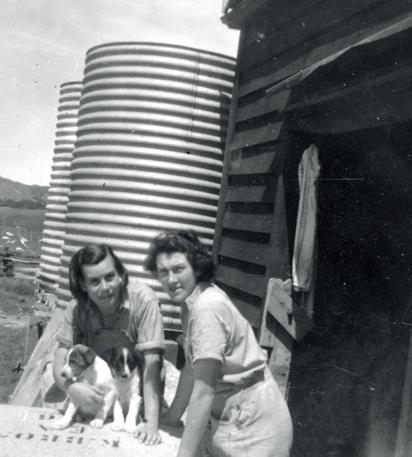
Agnes’s sampler from 1888 shows a new level of skill and artistry.
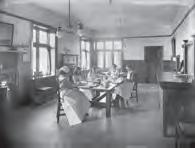

Top left: Jeanie Lawson made this sampler as a thirteenyear-old at Kilconpuhar School in Scotland in 1886. Alphabets and numbers are a common feature in samplers.
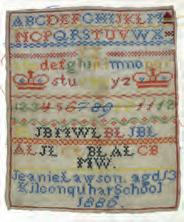

Bottom left: Agnes Lawson, aged twelve, made this sampler in 1887. Samplers would often feature an uplifting religious puote, as in the centre here.
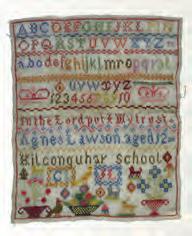 Young housemaids using their sewing skills, possibly in Christchurch, during the 1910s.
Young housemaids using their sewing skills, possibly in Christchurch, during the 1910s.
Some school subjects haven’t changed much over the last two centuries –reading, writing and maths, for example. But kids these days would probably never find ‘embroidery’ on their report card.
For young girls who went to school in nineteenth-century Britain, embroidery was part of the curriculum. People regarded it as an essential skill for life. The samplers shown here tell something of that story.
to embroider the family monogram on all the household bed and table linen.
‘The samplers shown here are from the 1880s,’ says Stephanie. ‘They were made by two sisters in Scotland. Jeanie Lawson did the earliest one as a thirteen-year-old. One year
initials will be those of family members who have died. The border of twisted strawberry stems is a distinctive feature in Scottish girls’ samplers. So is the peacock, which represents immortality or the Christian symbol of resurrection.’
‘Samplers were examples of lots of different embroidery stitches and patterns,’ says curator Stephanie Gibson. ‘Girls in British schools – and in some New Zealand ones – would make their first samplers when they were five or six years old. They’d learn their letters and their numbers making them.’

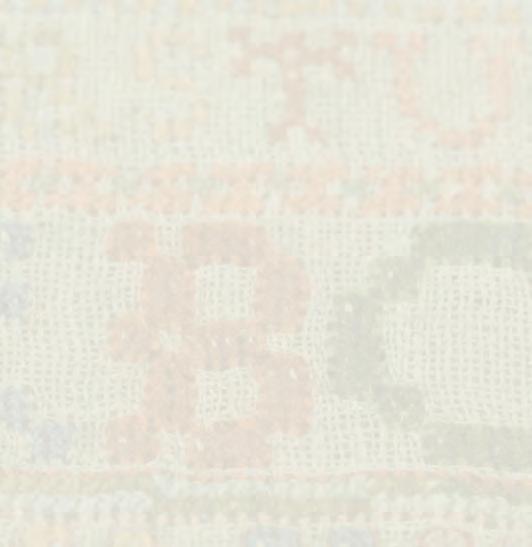

Girls learned embroidery to get them ready for family life and their jobs and roles after school. For example, they’d need to stitch family members’ initials on clothing so it could be identified. Or they might be servants to a wealthy family and have
later, her younger sister Agnes did a sampler that undoubtedly improved on Jeanie’s. Then the following year Agnes outdid both herself and her sister with an even more beautiful one.’
These samplers are a wonderful record of progress, of sibling rivalry maybe, but they are also family documents.
‘Many samplers had initials on them,’ says Stephanie, ‘mostly those of parents, grandparents and siblings. So on these samplers the CL and JL could be the sisters’ parents. Black is the colour of mourning, so black
Embroidery gave these young girls skills that served them well for the rest of their lives. And for their descendants and families, these samplers are like a living thread between them and their ancestors.
Curator Stephanie Gibson with samplers made by two Scottish sisters in the 1880s.
Black is the colour of mourning, so black initials will be those of family members who have died.
Humpty, Manu and Big Ted from Play School.
‘Here’s a house. Here’s a door. Windows – one, two, three, four. Ready to knock? Turn the lock ... Play School!’ These words set off a flood of memories for people who grew up in the 1970s and 1980s.
Play School was regular TV viewing for New Zealand kids, along with their parents and other family members.
Humpty Dumpty, Manu, Big Ted, Little Ted, Jemima ... who could forget the toy stars of this popular show?

‘ Play School ran from 1975 for about 15 years,’ says curator Kirstie Ross. ‘It was a based on a BBC children’s TV show that began in 1964 and was exported around the world.’
By the 1970s over ninety percent of households in Aotearoa had a TV.
With that coverage and almost no choice of channels, it’s no wonder that the show became part of popular culture and memory.
Humpty, Manu, Big Ted and Jemima – or at least surviving versions of them – now live in retirement at Te Papa.
‘The toys had a rough time on the show: they worked hard for
Like any stars, the Play School toys had their own wardrobes packed with amazing accessories.
Jemima, looking somewhat the worse for wear. Apparently she was rescued from a rubbish bin at a television studio before being donated to Te Papa.
A Mardi Gras mask. The Play School toys had their own wardrobes and accessories.
Big Ted’s flying helmet.
Riria with the four Play School star toys at Te Papa. The fifth main character, Little Ted (minus head), is at the Otago Settlers Museum.

their money,’ says Kirstie. ‘And they wore out. For example, Humpty had to be replaced e very two years. Poor Jemima is looking like she was definitely due to be scrapped.’
Like any stars, the Play School toys had their own wardrobes packed with amazing accessories.
‘There’s a Mardi Gras mask,’ says Kirstie, ‘and Big Ted’s flying helmet. There are the purses that the toys


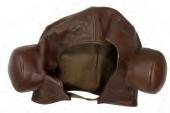
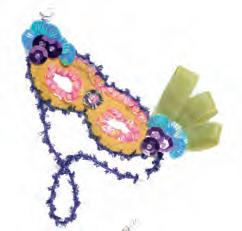
took out with them when they went shopping. And there’s Little Ted’s armour.’
So where is Little Ted? What happened to him?
‘There’s a rumour,’ says Kirstie, ‘that during Play School ’s last day of filming, somebody decided to blow Little Ted up. In fact, a headless Little Ted is now in the Otago Settlers
Museum. Maybe he should have been wearing his armour that day!’
The toys may be getting on in years, but they are among the most popular items in Te Papa’s history collection. So keep a lookout for any former versions of them ... and Little Ted’s head.
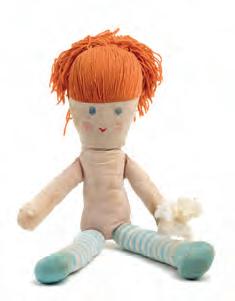 Little Ted’s armour.
Little Ted’s armour.
A louse specimen is sealed in resin on this glass slide.
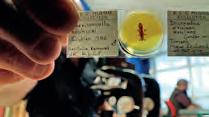
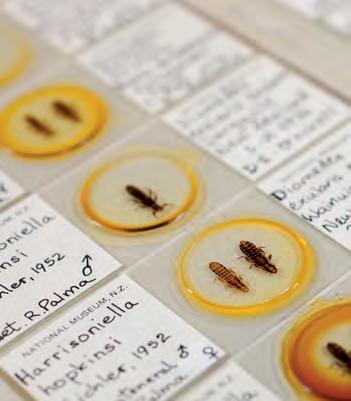
Curator Ricardo Palma has studied lice for over forty years and is internationalan expert on them.
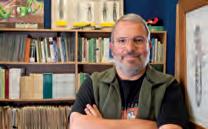
A male Austrogoniodes waterstoni, the only louse species that lives exclusively on little blue penguins.

Ricardo’s drawing of Naubates (Naubates) thieli for one of his publications on seabird lice.
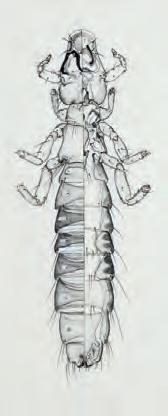
New Zealand is sometimes called the world capital of seabirds, it has so many and such a variety living on its shores and seas.
That was a huge attraction to a young Argentinian scientist who emigrated here in the 1970s. But he was drawn less by the birds than by what lives on them.
‘You look at a bird flying and see one animal,’ says curator Ricardo Palma. ‘I see a flying zoo. Birds can have thousands of parasites living on their skin or in their feathers at any one time. And the crème de la crème of parasites are lice.’
Ricardo’s love affair with lice began when he was a student in Argentina. So when he came to this paradise for sea and shorebirds, he decided it must be a paradise for their lice too.
In his time here he has collected over seventy thousand specimens of more than a thousand species, mainly from seabirds.
‘I also found seven headlice on a 1500-year-old Egyptian comb,’
‘Lice are very tough: they’ll remain on the bird for many years, like mummified lice.’
To collect the specimens he gives their host a good shake over a tray. He then processes each louse until all that’s left is its tiny transparent skeleton. This he mounts in resin on a glass slide and bakes in an oven for about two weeks.
The specimen is then ready to carry on for a very long time indeed, but now as an object of study for researchers.
Most warm-blooded animals with hair, fur or feathers have lice. Lice are nature’s ultimate hitchhikers – they spend their lives catching rides and feeding on their hosts. When the host dies, so do the lice, unless they can catch a new ride.
says Ricardo. ‘I even collected one from myself!’
Most of his specimens come from dead birds – like those washed up on beaches during storms.
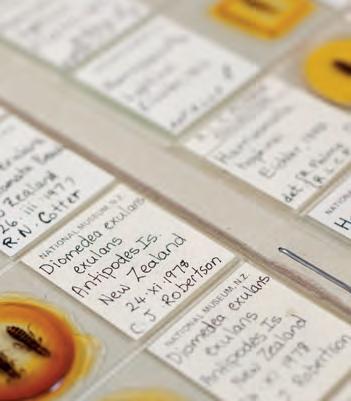
‘We can also collect lice from taxidermied specimens,’ says Ricardo.
Ricardo has processed and identified so many lice he’s become an international expert. Just by looking at a louse he can identify the species and tell you which type of bird it’s from – or even if it’s lived on a human.
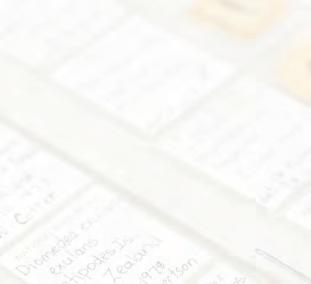
Microscope slides preserving giant wing lice that were found amid the feathers of wandering albatrosses.
‘You look at a bird flying and see one animal, I see a flying zoo. Birds can have thousands of parasites.’
Occasionally photography just doesn’t make the grade. Sometimes nothing beats a hand-drawn illustration in black and white – especially when it comes to identifying fishes.
Mi ch el le F re eb or n is a s ci en ti fi c
d rawing t h e specimens in Te Papa’s fish collection ,
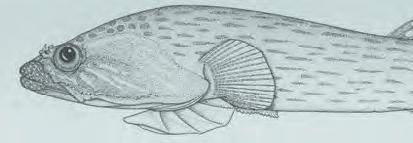
Michelle Freeborn is a scientific illustrator. She spends her days drawing the specimens in Te Papa’s fish collection, combining her artistic skills with scientific observation to portray the subject.
‘Sometimes photographs don’t show a fish’s detail,’ says Michelle. ‘A reference image has to be quickly recognisable. It’s my job to bring out all those key characteristics in the drawing.’
o b serv atio n to por tray t h e s u b ject ‘Sometimes p h otograp h s d on’t s how ‘A A ref eren ce i ma ge h as to be qu ic kl y re co gn is ab le . It ’s s m y jo b to b rin g out a ll t h ose c h aracteristics in the d ra wi n g . ’
She works with the scientists to clarify shapes and layers, and

M ic h e ll e l i kes to d raw a specimen as soon as pos sibl e afte r th e fish team
Sh e wo rk s wi th t he s ci en ti st s to emp h asise important d etai l s, s ometimes a re d ama g e d.
to emphasise important details, sometimes with specimens that are damaged.
’ When the fish is fresh , the colours
an d textures are muc h c l earer and bri g hter,’

Michelle likes to draw a specimen as soon as possible after the fish team have defrosted and processed it. ’When the fish is fresh, the colours and textures are much clearer and brighter,’ she says.
A ccuracy
this t ype o f a rt Re crea ti on al a nd prof es si on al fishe rs, as w ell as scientists an d researc h ers , use h er
Her drawin g s
Accuracy is the essence of this type of art. Recreational and professional fishers, as well as scientists and researchers, use her work to compare and identify fish. Her drawings also appear in scientific publications around the world.
R ulers asM ichell emeasurest he spe ci men
Rulers and callipers are vital tools as Michelle measures the specimen from point to point. That’s sometimes around a hundred measurements for a single fish.
‘The more measurements you take,’ she says, ‘the better you can cross-reference them on the actual illustration, so you know you’ve got everything in the right place.’
‘T h e more measurements you take,’ s he says, ‘th e bett er you can cros s- re fe re nc e th em o n th e ac tu al i ll ustration, so you k now you’ve g ot everyt h ing in t h e rig h t p l ace. ’
She does all her drawings on an A3 sheet, so she has to draw the fish to scale – larger or smaller than in real life. It has to fit the page, whether it’s a tiny clingfish or a large shark or ray.
Sh e d o es a ll h er d ra wi n g s on an A3 s heet , so s he h as to draw the fish to sca l e – l arger or sma ll er t h a n in rea l pa g e, whether it’s a clin g fish or a larg e or M ichelle has been a scienti f ic ill ust ra to r s in ce s h e c am e to stu d ie d ar t an d d esi g n t h e re, an d wo rked f or over years in t he
Michelle has been a scientific illustrator since she came to New Zealand from the UK. She’d studied art and design there, and worked for over fifteen years in the British film industry, including doing special makeup effects in Jim Henson’s Creature Shop.
‘When I came here, I heard about a job at Te Papa drawing fishes,’ she says. ‘I didn’t know anything about New Zealand fish or fish science, so I bought a fish at the supermarket and drew it. I came to the interview with the drawing and my portfolio ... and here I am.’
a j ob at Te Papa drawin g fishes,’ she says ‘ Ididn’ t kn owany thin g ab out
c illustrator Michelle Freeborn at her drawing board.Occasionally just doesn’t make the Sometimes nothing beats a hand-drawn illustration in black and white – especially when it comes to identif ying fishes.
‘Sometimes photographs don’t show a fish’s detail, it’s my job to bring out all those key characteristics in the drawing.’
Michelle’s drawing specimen, like the one in Michelle’s drawing.

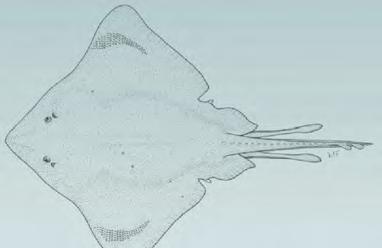
Michelle’sdrawing Michelles of a lumpfish (left) g an d a de epsea skate.
M ichelle renders all the fish’s texture and colo ur p atterns in d ots. Dots make th e im age lo ok tig ht and crisp. That way, all the gg d etails rem ain cl e ar y when it’s reduced in size for p ublication.

A p hoto gra p h of a pricklypgpanglerfish p sp ecim en, like the yg e’s d rawing.
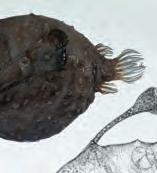


Riria is connected, thanks to technology of the twenty- first century. In the background the portrait of Mrs DevereuxHumphreyoffers an eighteenth-century example.
Living overseas far from loved ones can be hard. But these days fast travel and internet contact can help make separation bearable. None of that existed in 1770 when John Greenwood in England yearned for another sight of his mother.
He was working as an art dealer in London and knew he was unlikely to ever go back to Boston to see her.

Greenwood wrote, ‘I am very desirous of seeing the good lady’s face as she now appears, with old

‘I am very desirous of seeing the good lady’s face as she now appears, with old age creeping up
‘So he wrote a letter to his friend, the artist John Singleton Copley,’ says collection manager Tony Mackle, ‘to get him to paint his mother’s portrait.’
Copley was a good person to ask. He was noted for being able to capture a good likeness in his subjects – which was of course the main point of a portrait then. There were no photographs to have as mementos.
age creeping up on her.’ He made one condition – that she should be dressed in serious-looking clothing.
The end result, Mrs Humphrey Devereux , was a masterly example of Copley’s rich and meticulous detailing and lifelike work.
‘Copley was painting a portrait for somebody who believed he wouldn’t see that person again,’ says
on her.’
Tony. ‘So he paid close attention to the detail of her skin and the face. You can see how natural it all looks – the wrinkled skin, the folds of her clothing. What comes across too is a sense of her great strength of character and her wisdom of age.’
John Greenwood was right: he never did see his mother again in the flesh. Apparently, though, he was delighted with the painting.
It stayed in the family, but the family didn’t stay in England. Greenwood’s son moved to New Zealand with his wife and children in the 1840s and Mrs Humphrey Devereux came with them. In 1965 the Greenwood descendants gave the picture to the museum.
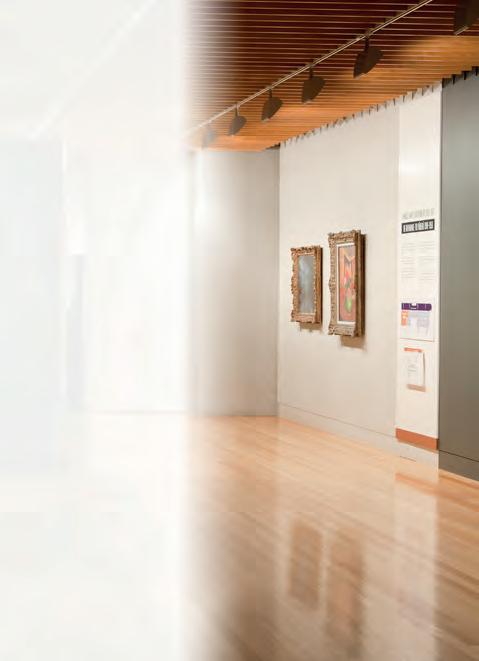
Mrs Humphrey Devereux may have died more than two hundred years ago, but this portrait of a beloved mother forever captures an essence of her living presence.
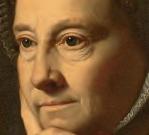
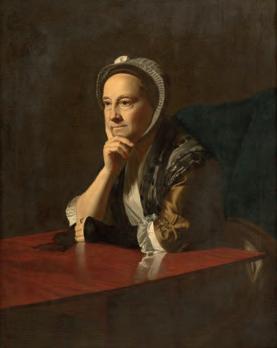
Artists Charles F Goldie and Gottfried Lindauer are famous for their lifelike portraits of Māori men and women. At the same time as they were painting their subjects in their studios, Bessie Murray was making detailed sketches of hers.
But Bessie was drawing outside a bakery in Taihape, not in an artist’s studio. And her finished products were dolls, not oil paintings.
Bessie was a widow living in Taihape. She had two children to bring up, and she needed to earn money to provide for them. So around 1913, in her mid-twenties, she turned her hand to making dolls.
She made dolls based on nurseryrhyme characters and dolls that had the look of European pioneer children. But the dolls that many people sought out were her Māori mother-and-baby ones.

Her subjects for these were the women who came with their babies to the local baker’s shop. She drew them as they socialised around the bench outside. Then she took her drawings
home and developed the dolls from her observations.
‘The closer you look at these dolls, the more you see,’ says curator
‘In fact Bessie’s reputation was such that people would come and commission her to make the dolls. And she knew the value of her work,
Stephanie Gibson. ‘She’s painted moko on the faces, she’s made hei tiki and jewellery out of little glass beads. She’s simulated tāniko weaving with black embroidery for the kete. She’s made tie-dyed silk skirts. You can see she’s gone to great efforts to make the dolls look as realistic as possible.’
Bessie sold her dolls at drapery stores and tourist outlets throughout the lower part of the North Island.
‘They were popular right through the 1920s and 1930s,’ says Stephanie.
which was crucial to her livelihood. She registered two of her designs with the Patent Office.’
Bessie Murray’s dolls were in demand, not just for their distinctive subjects, but because they were created with beauty and sensitivity. Today they are not only rare works of art. They are also, in their own way, valuable portraits from a long-gone time.
Te Papa’s collection has three of Bessie Murray’s Màori mother-andbaby dolls, shown here with curator Stephanie Gibson.
‘She’s painted moko on the faces and she’s made hei tiki and jewellery out of little glass beads.’
The peepsbaby out from the mother’s shawl. Bessie painted the facial features and moko.

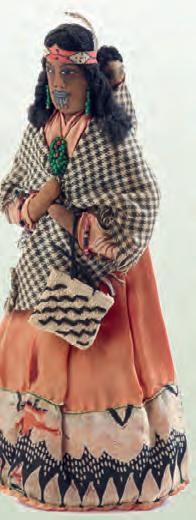
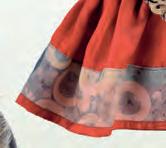

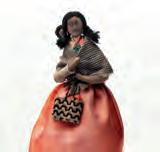
These mother-andbaby dolls were made about 1930. Hei tiki and earrings were made of glass beads.

The taiaha Te Rongotaketake, a weapon of war that became a symbol of peace around 1820.

most places – a white flag is a symbol of truce. Raising it usually brings fighting to a standstill and may open the way for lasting peace.
Sometimes the very weapon used in battle may also become a symbol of peacemaking, as with the taiaha named Te Rongotaketake.
‘Te Rongotaketake belonged to the Ngāti Ira people of the Wellington–Cook Strait area,’ says curator Matiu Baker. ‘Around 1820, Ngāti Ira came under attack from a
‘The northern party met stiff resistance from Ngāti Ira,’ says Matiu. ‘But at some point during that time, peace was made between Ngāti Ira and Ngā Puhi. We don’t know precisely how this taiaha came to be a symbol of peacemaking. We do know that it was named Te Rongotaketake, meaning “a firm and lasting peace”.’
large war party from Ngā Puhi and Ngāti Toa. These tribes had come down from the north, making a series of raids along the western coast of the North Island.’
This was known as the Amiowhenua, or ‘encircling the land’, expedition. It was one of the largest Māori war expeditions of that period, probably with several hundred people involved.
It was quite common for peace between tribes to be symbolised by the gift or exchange of a prized weapon – for example, a mere pounamu (a short-handled striking weapon) or, as here, a taiaha.
Te Rongotaketake passed through many different hands. From the Ngā Puhi leaders it went to another famous warrior chief, Te Ruki (The Duke) Kawiti. Kawiti

War can cross continents and cultures, but one sign means the same thing inFamed warrior Tamati Waka Nene was one of the Ngà Puhi leaders of the Amiowhenua expedition.
It was quite common for peace between tribes to be symbolised by the gift or exchange of a prized weapon.

gave the taiaha to Auckland Police Commissioner James Naughton, again as a peace offering, about 1847. Over 150 years later, Te Papa purchased Te Rongotaketake at auction.
Te Papa has over 360 taiaha, but most have a mysterious past. Te Rongotaketake stands out as one of the few with a traceable history. It also has a special place in the history of Wellington.
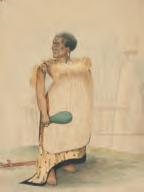
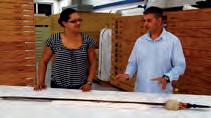
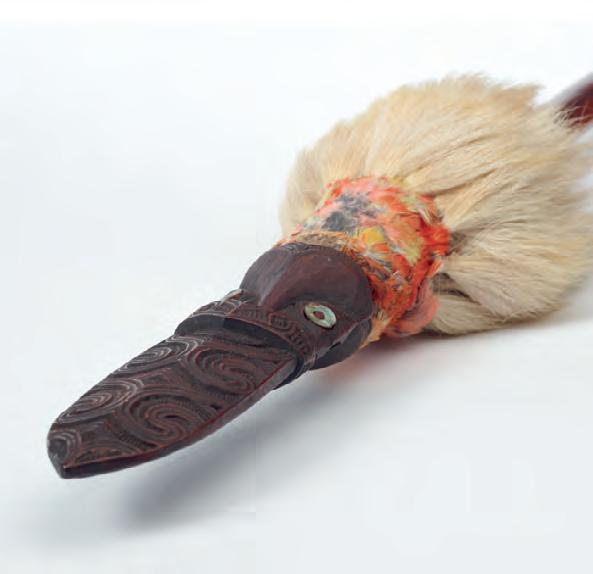 Curator Matiu B aker and Riria with Te Rongotaketake.
Curator Matiu B aker and Riria with Te Rongotaketake.
The famous Ngàti Toa leader, Te Rauparaha. The Amiowhenua expedition led him to return to settle in the Cook Strait area some years later with his people and various allies.
Taiaha may look like spears, but they are weapons for close- puarters combat. The pointed end of such a fighting staff is used for thrusting, the bladed end for striking.
Sean’s own tatau. Pieces like this are popular in Aotearoa as ways of showing commitment to your Samoan identity and culture.
Noted photographer Mark Adams has documented tatau in Aotearoa since the 1970s. His photos are often taken in people’s living rooms or garages, typical settings for tatau these days.
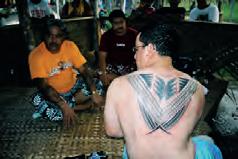
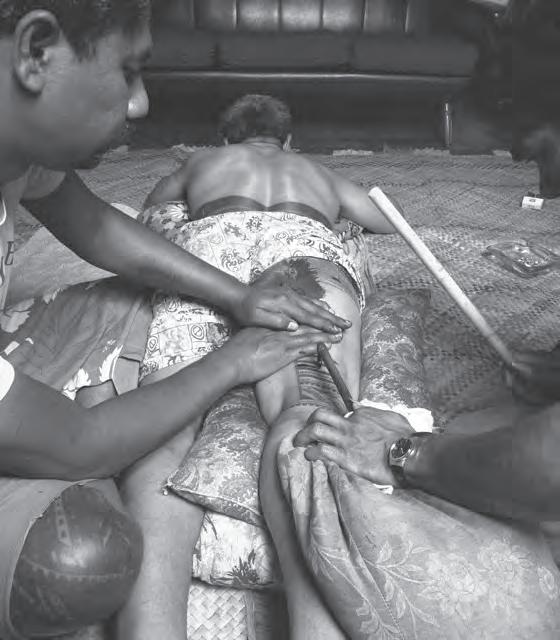
The English word ‘tattoo’ dates back to the tales and images of Pacific ‘tatau’ that came from James Cook’s eighteenth-century voyages of exploration. Tattoo, in word and fashion, went global. Its forms multiplied and its tools became metal, then electric. Today it’s hugely popular as skin adornment.
Meanwhile Samoan tatau has continued – using small boar’s tusk combs, each puncture tapped in with patient strokes of a hammering stick –as it has for thousands of years.
‘In Samoan custom, tatau is something you undertake as you move into another stage of your life,’ says
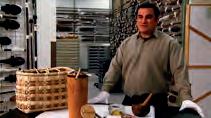
equivalent for women: it covers the leg from the upper thigh to behind the knee, but is not as dense as the pe‘a.
‘Other smaller forms of tatau have become popular, especially in New Zealand,’ says Sean, ‘the taulima on the arm, or pieces on the back,
or tattoo experts. But the detail is individual to each artist.
The tufuga has a range of combs to produce marks of different sizes and shapes. Large combs are used for areas of block colour, smaller combs for more detailed parts or motifs. A single tatau session may take three or four hours. There will be several of these over a period of weeks or even months. Family support is vital for the person to endure the process.
curator Sean Mallon. ‘It’s about taking on new roles, new responsibilities. For example, individuals will get particular forms of tattoo so they can perform duties for Samoan chiefs on ceremonial occasions.’
The most important tatau for men is the pe‘a, dense tattooing completely covering the lower body from waist to knee. Malu is the
Curator Sean Mallon with the customary tools of tatau — the way of Samoan tattoo, practised for several thousand years.
chest or shoulder. For some people these tattoos can express their Samoan identity. But for ceremonial occasions it’s the pe‘a and the malu that count.’
The person getting a pe‘a or malu doesn’t really have a say in its look. The design has a structure that’s followed by most tufuga tatatau,

Sean has had a back piece done and knows first hand what tatau feels like.
‘For most Samoans who choose it, undergoing customary tatau is a major commitment – to both the art and Samoan culture,’ he says. ‘Those markings are not easily removed. They’re for life.’
The instruments of tatau, much like those still used in Samoa and New Zealand. Boar’s tusk is cut into combs of various sizes. Ink is made from candlenut soot.

The most important tatau for men is the pe‘a, dense tattooing completely covering the lower body from waist to knee.
Mr Punch, with his characteristic hook nose and red costume. He was brought to Britain by Italian comic performers in the late seventeenth century and first appeared there as Punchinello.



Punch’s wife Judy, as characterised by Frost. Her hair, in rollers, spoofs Kiwi housewives of the time.
A magic lantern slide of a traditional Punch and Judy in the early 1900s. Magic lanterns were a type of image projector developed in the seventeenth century.
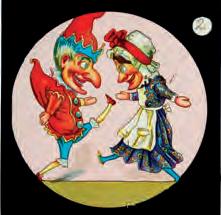
A Punch and Judy show poster.

‘Pleased as Punch’ is an old phrase to describe happiness. It comes from the maniacal delight taken by puppet character Mr Punch in his latest bit of wrongdoing.
Punch and Judy puppet shows have been part of British popular entertainment for several hundred years. They are outrageous, anarchic, full of topical references and satire, with a well-known cast of characters and wonderfully predictable plots.
In the late 1970s Garth Frost created a Kiwi version of the show. This artist and actor did his puppeteering under the guise of Captain Frootkakes. His show featured in the Wellington City Council’s first ‘Summer City’ festival, 1979.

surreal TV set spilling baked beans. It’s like a freeze-frame of popular culture at the time.
‘It reflects punk rock and that artistic style of the late 1970s,’ says Lynette. ‘But also you need to remember that Garth’s audience was primarily children. The fact that you could get away with doing a show like this –that reflects the time as well.’
Frost did his show for quite a few years in Aotearoa. He then took it on the road to Australia and England, and to Cyprus, where he performed for
Frost performed with all the usual suspects like the notorious Punch and his wife Judy and their baby. But to add some local flavour he modelled the hangman on the prime minister then, Robert Muldoon. That gave him plenty of opportunity for political satire.
‘Muldoon was often referred to as Piggy Muldoon,’ says curator Lynette Townsend. ‘So the hangman’s got a piggy snout and little trotters.’
The set portrays a wacky Kiwi lounge room featuring booze in various forms, plaster ducks, a mocking portrait of the Queen, and a
several years.
‘He used the same script translated into Greek,’ says Lynette, ‘Apparently the kids there loved it too: they laughed in all the right places.’
Garth Frost is still working with puppets, although not Punch and Judy. They’ve taken their last bow and retired to Te Papa. And that, you could say, has made the museum pleased as Punch.

Riria with the stage set for Garth Frost’s Punch and Judy puppet show.
Frost’s Punch and Judy performing for an audience of children.
Punch and Judy puppet shows ... are outrageous, anarchic, full of topical references and satire.
Simon Morton and Riria Hotere
RRP: $35 ISBN: 978-1-877385-79-7 PUBLISHED: September 2012 PAGE EXTENT: 224 pages FORMAT: Limpbound SIZE: 240 x 110 mm
FOR MORE INFORMATION OR TO ORDER https://www.tepapa.govt.nz/about/te-papa-press/history-books/100amazing-tales-aotearoa